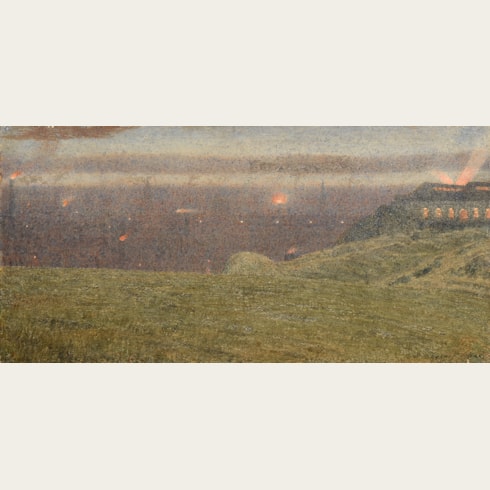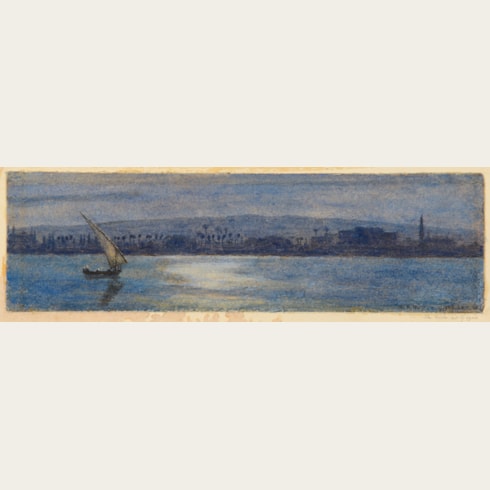George Price BOYCE
(London 1826 - London 1897)
Venice by Moonlight: Santa Maria della Salute from the Riva degli Schiavoni
Sold
Watercolour, with touches of bodycolour, on oatmeal paper.
Signed with the artist’s monogram and dated GB 54 at the lower left.
Signed, dated and inscribed Venice / GB Sept. 1854 on the verso.
Titled The Salute and Venice in the lower margin of the former backing sheet. Further inscribed, signed and dated from the Riva degli Schiavoni – Venice / by moonlight / George P Boyce. 1854. on the former backing sheet.
153 x 229 mm. (6 x 9 in.)
Signed with the artist’s monogram and dated GB 54 at the lower left.
Signed, dated and inscribed Venice / GB Sept. 1854 on the verso.
Titled The Salute and Venice in the lower margin of the former backing sheet. Further inscribed, signed and dated from the Riva degli Schiavoni – Venice / by moonlight / George P Boyce. 1854. on the former backing sheet.
153 x 229 mm. (6 x 9 in.)
In the summer of 1854 George Price Boyce made a visit to Venice, at the suggestion of John Ruskin. On the 14th of June, Ruskin wrote to Boyce in Venice: ‘I am vexed at thinking that I have perhaps been partly instrumental in leading you into the expense and trouble of a long journey, when there was quite enough material to employ you delightfully nearer home. But as you are at Venice, I congratulate myself, in the hope of at last seeing a piece of St. Marks done as it ought to be: It cannot be quite superogatory to point out to you the superior interest of St. Marks to all else in the city. It answers precisely to your wishes, as expressed in your note, “near subject – good architecture – colour - & light & shade”. I think the more you study it, the more you will enjoy it...I do not exactly know how far, at first sight, you may be able, for yourself, to distinguish what is really best worth your while. For my own part, it always takes me a week or two before I find out the best things, and unless you have been accustomed to the study of architecture, you may be so dazzled by the splendour of effect in Venice as not to estimate justly the value of Verona.’
This was to be Boyce’s only visit to Venice, and during the few months that he spent there he produced detailed architectural studies and watercolours of the type encouraged by Ruskin, as well as a handful of more atmospheric and freely-drawn views of the city by night; works that would have been less likely to gain Ruskin’s approval. As Christopher Newall and Judy Egerton have written, ‘Boyce was evidently delighted by everything he saw in Venice; in the four months or so that he spent there he produced many remarkable watercolours. If his first object was to record the architectural monuments which he and Ruskin feared were in danger of destruction or insensitive restoration, on other occasions he painted hidden corners of the city and crowded side-canals. Sometimes he ignored Ruskin’s admonitions against generalised and crepuscular effects and described the vespertine or nocturnal city in semi-abstract studies in which the form of buildings and ships loom from the broadly handled areas of monochromatic tone. [Such watercolours] speak of the romantic impression that Venice made on the young artist rather than his dutiful observation of her architecture.’
This watercolour, dated September 1854, is among the finest examples of Boyce’s more atmospheric Venetian views. Among stylistically comparable watercolour nocturnes of the city by the artist is San Giorgio Maggiore from the Piazzetta – Moonlight Study in a private collection. One critic’s apt description of that watercolour, at the time of its exhibition at the Old Water Colour Society in 1868, may equally be applied to the present sheet: ‘For solemnity of effect and breadth of colour, “St. Giorgio Maggiore, Venice” - the towers and domes of the city – have no superior here. Small as it is, this shows the work of an artist and the feeling of a poet.’
As Allen Staley has noted of George Price Boyce, ‘A number of the Venetian watercolours are remarkably broad and atmospheric. On coarse paper...and in a murky, almost monochromatic palette, they show that Boyce still retained his liking for twilight despite Ruskin’s advice.’ That the artist’s interest in such effects continued well after his return from Venice is seen in a number of watercolours of the Thames at night that he produced in the early 1860s. An entry in Boyce’s diary from June 1863 notes that he had made ‘a study of moonlight effect on river from my balcony’, and in the same year his friend James McNeill Whistler made an etching of the river from the window of Boyce’s studio overlooking the Thames at Blackfriars. It has been suggested that Boyce’s watercolours of this type may have inspired Whistler’s own Thames nocturnes, which he began to paint around 1870.
This was to be Boyce’s only visit to Venice, and during the few months that he spent there he produced detailed architectural studies and watercolours of the type encouraged by Ruskin, as well as a handful of more atmospheric and freely-drawn views of the city by night; works that would have been less likely to gain Ruskin’s approval. As Christopher Newall and Judy Egerton have written, ‘Boyce was evidently delighted by everything he saw in Venice; in the four months or so that he spent there he produced many remarkable watercolours. If his first object was to record the architectural monuments which he and Ruskin feared were in danger of destruction or insensitive restoration, on other occasions he painted hidden corners of the city and crowded side-canals. Sometimes he ignored Ruskin’s admonitions against generalised and crepuscular effects and described the vespertine or nocturnal city in semi-abstract studies in which the form of buildings and ships loom from the broadly handled areas of monochromatic tone. [Such watercolours] speak of the romantic impression that Venice made on the young artist rather than his dutiful observation of her architecture.’
This watercolour, dated September 1854, is among the finest examples of Boyce’s more atmospheric Venetian views. Among stylistically comparable watercolour nocturnes of the city by the artist is San Giorgio Maggiore from the Piazzetta – Moonlight Study in a private collection. One critic’s apt description of that watercolour, at the time of its exhibition at the Old Water Colour Society in 1868, may equally be applied to the present sheet: ‘For solemnity of effect and breadth of colour, “St. Giorgio Maggiore, Venice” - the towers and domes of the city – have no superior here. Small as it is, this shows the work of an artist and the feeling of a poet.’
As Allen Staley has noted of George Price Boyce, ‘A number of the Venetian watercolours are remarkably broad and atmospheric. On coarse paper...and in a murky, almost monochromatic palette, they show that Boyce still retained his liking for twilight despite Ruskin’s advice.’ That the artist’s interest in such effects continued well after his return from Venice is seen in a number of watercolours of the Thames at night that he produced in the early 1860s. An entry in Boyce’s diary from June 1863 notes that he had made ‘a study of moonlight effect on river from my balcony’, and in the same year his friend James McNeill Whistler made an etching of the river from the window of Boyce’s studio overlooking the Thames at Blackfriars. It has been suggested that Boyce’s watercolours of this type may have inspired Whistler’s own Thames nocturnes, which he began to paint around 1870.
George Price Boyce was trained, and began his career, as an architect. Following a meeting with David Cox at Betws-y-Coed in Wales in 1849, however, he decided to take up landscape painting. He received lessons from Cox, whose influence can be seen in Boyce’s early watercolours. Not long afterwards he met Dante Gabriel Rossetti, who was to become an intimate and lifelong friend, and, a few years later, William Holman Hunt and John Everett Millais. These three young artists, who formed the nucleus of the Pre-Raphaelite Brotherhood, founded in 1848, discovered a kindred spirit in Boyce. Of independent means, he began avidly collecting their work (eventually owning more than forty works by Rossetti), while writing about them in his diaries between 1851 and 1875, which serve as an important record of the Brotherhood’s activities.
Boyce only rarely painted landscapes in oil, and most of his work is in watercolour. His landscapes, usually of views in the Thames valley, were exhibited at the Royal Academy from 1853 onwards, and frequently at the Old Water-Colour Society, of which he became an Associate in 1864 and a full member in 1877. Having once considered a career as an architect Boyce was passionately interested in old buildings and produced a large number of precise watercolour views of rural architecture; of farms, mills and manor houses. On the advice of John Ruskin, he made trips to Venice and Verona in 1854 and Switzerland in 1856; he also spent a few months in Egypt between 1861 and 1862. On his return from Egypt he began using Rossetti’s old studio in Blackfriars, on the Thames, and there became friendly with James McNeill Whistler. In 1869 he had a house built for him in Chelsea by the architect Phillip Webb, where he lived until his death in 1897.
As Virginia Surtees has written of Boyce, ‘From his own water-colours he expected little, his innate modesty debarring any confidence of success...The touchstone of his whole working life was the desired excellence of execution. His subjects were mostly architectural, usually seen in the context of a peaceful English countryside, perhaps at sunrise or in the blaze of midday when the successful contrast of shadow to the full exposure of the summer heat, or that of red brick to a harvested cornfield, were all that he aspired to...Faithful to a vision of simplicity and goodness he interpreted these with a serenity and unpretentious charm which were the reflection of his own character.’ Christopher Newall has added that ‘[Boyce’s] works, although small in scale and most intimate in their means of expression, are sincere and delicately beautiful.’






